Theodore Roosevelt has been ranked as one of the five best presidents the United States of America ever had. We have gathered a complete collection of Theodore Roosevelt Facts For Kids that will enable the kids to learn all about Theodore Roosevelt. In this Theodore Roosevelt Biography For Kids you are going to learn who he was, his name, nicknames, birth, ancestry, family, early life, education, marriage, kids, grandkids, life before the presidency, political party, his rise, war of 1812, how he became president, death, noble prize, accomplishments, trusts, progressive reforms, progressive era, conservation, imperialism, defense, foreign policy, environment, immigration, civil rights, life after the presidency, letters, quotes, books and many other interesting facts about Theodore Roosevelt.
THEODORE ROOSEVELT FACTS FOR KIDS
Who Is Teddy Roosevelt – Who Was Theodore Roosevelt
- Theodore Roosevelt was an American politician, statesman, and writer.
- He was a leader of the Republican Party.
- From 1899 to 1900, he served as the 3rd governor of New York.
- In 1901 (from March to September), he served as the 25th vice president of the United States.
- From 1901 to 1909, he served as the 26th president of the United States.
- Polls of historians and political scientists ranked him as one of the five best presidents of the United States.
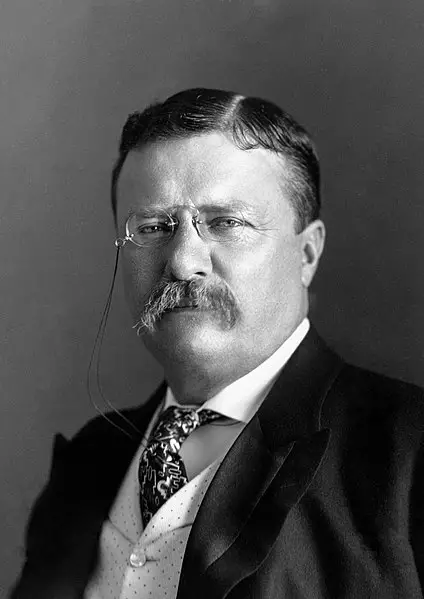
What Was Theodore Roosevelt Full Name
- The full name of Theodore Roosevelt was “Theodore Roosevelt, Jr.”.
What Was Theodore Roosevelt Nickname
- Theodore Roosevelt had the following nicknames:
- Teddy
- Teedie
- Telescope Teddy
- The Bull Moose
- The Man of Horseback
- The Rough Rider
- The Lion
- The Old Lion
- Haroun-Al-Roosevelt
- T.R.
- The Meddler
- The Trust Buster
- The Driving Force
- The Dynamo of Power
- The Happy Warrior
- The Great White Chief
- The Hero of San Juan Hill
When Was Theodore Roosevelt Born
- Theodore Roosevelt was born on 27 October 1858.
Where Was Theodore Roosevelt Born – Birthplace Of Teddy Roosevelt
- The birthplace of Theodore Roosevelt is located at 28 East 20th Street, Manhattan, New York City.

Theodore Roosevelt Ancestry
- Theodore Roosevelt belonged to a prominent business and political family “Roosevelt” from New York.
- He was the grandson of Cornelius Van Schaack “C.V.S” Roosevelt, who was of Dutch descent.
- His other ancestry was primarily of Scottish and Scot-Irish, English, as well as French, German, and Welsh to a little extent.
- Theodore Roosevelt was a descendant of the Schuyler family through Van Schaack.
Theodore Roosevelt Family
- Theodore Roosevelt was from the “Roosevelt” family, which was a prominent business family in the New York state of America.
- They were the descendants of the Dutch immigrants, who migrated to New Amsterdam (a Dutch settlement at the south of Manhattan Island in the 17th century) in the mid of 17th century.
- Many members of this family were prominent merchants, artists, clergymen, inventors, socialites, and politicians.
Who Were Teddy Roosevelt’s Parents
- The father of Theodore Roosevelt was ‘Theodore Roosevelt Sr.’, who was a philanthropist and businessman. He was the son of a prominent businessman, Carnalius Roosevelt.
- His mother, Martha Stewart “Mittie” Bulloch was a socialite and daughter of Major James Stephens Bulloch.
Who Were Theodore Roosevelt’s Siblings
- Theodore Roosevelt had three siblings, a brother Elliott Bulloch Roosevelt, and two sisters; Corinne Roosevelt Robinson and Bamie Roosevelt.
Theodore Roosevelt Early Life – Theodore Roosevelt As A Kid
- In the early life of Theodore Roosevelt, he was called ‘Teedie’ and then ‘Teddy’.
- As a kid, he was weak and had poor health and deliberating asthma.
- During his childhood, he experienced nighttime asthma attacks repeatedly, which was terrifying for him and his parents.
- He was energetic and curious and started taking interest in zoology from the age of only seven years.
- In his teenage years, he overcame his poor health and built up his strength by following the programs of weightlifting and gymnastics.
- His father was one of the prominent leaders in the cultural affairs of New York who greatly influenced him.
- At an early age, he went on abroad tours with his family, including trips to Europe and Egypt.
- Theodore Roosevelt witnessed the funeral procession of Abraham Lincolin from the mansion of his grandfather in Union Square (New York City) when he was 6 years old.

Theodore Roosevelt Education
- Theodore Roosevelt obtained his initial education at home from tutors and his parents.
- He was good in biology, philosophy, history, French, and Germen. However, he struggled in Greek, Latin, and mathematics.
- He graduated from Harvard College with an A.B. magna cum laude.
Theodore Roosevelt At Harvard
- Theodore Roosevelt entered Harvard College on 27 September 1876.
- There, he participated in boxing and rowing.
- He had a membership of the Delta Kappa Epsilon fraternity, the Alpha Delta Phi literary society, and the Porcellian Club.
- He was also an editor of the art and literary magazine of Harvard College; The Harvard Advocate.
- From Harvard, he graduated Phi Beta Kappa with an A.B. magna cum laude in 1880.
Who Did Teddy Roosevelt Marry – Who Is Teddy Roosevelt’s Wife – Theodore Roosevelt Spouse
- Theodore Roosevelt first married Alice Hathaway Lee in 1880 at the age of 22 years.
- He then married Edith Kermit Carow in December 1886 about two years after the death of his first wife.
Who Was Theodore Roosevelt’s First Wife
- The first wife of Theodore Roosevelt was Alice Hathway Lee.
- She was an American socialite.
- Her cousin and next-door neighbor was a classmate of Theodore Roosevelt at Harvard University.
- They married in 1880 and their daughter (Alice Lee Roosevelt) was born in 1884.
- She died of undiagnosed kidney failure only two days after giving birth to her daughter.
Teddy Roosevelt Kids
- Theodore Roosevelt had six children:
- Alice Lee Roosevelt (daughter)
- Theodore Roosevelt Jr. Ⅲ (son)
- Kermit Roosevelt (son)
- Quentin Roosevelt (son)
- Archibald Roosevelt (son)
- Ethel Roosevelt (daughter)
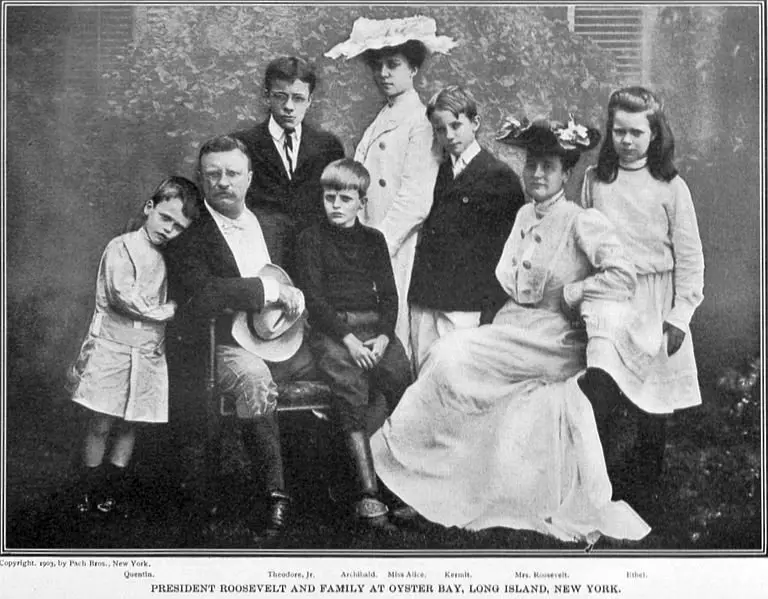
Theodore Roosevelt Grandchildren
- The following are grandchildren of Theodore Roosevelt:
- Paulina Longworth Sturm (via Alice Lee Roosevelt)
- Theodore Roosevelt Ⅳ (via Theodore Roosevelt Jr. Ⅲ)
- Quentin Roosevelt Ⅱ (via Theodore Roosevelt Jr. Ⅲ)
- Cornelius V.S. Roosevelt (via Theodore Roosevelt Jr. Ⅲ)
- Grace Green Roosevelt (via Theodore Roosevelt Jr. Ⅲ)
- Kermit Roosevelt Jr. (via Kermit Roosevelt)
- Joseph Willard Roosevelt (via Kermit Roosevelt)
- Drick Roosevelt (via Kermit Roosevelt)
- Belle Wyatt Roosevelt (via Kermit Roosevelt)
- Edith Derby Williams (via Ethel Roosevelt)
- Sarah Derby Gannett (via Ethel Roosevelt)
- Richard Derby Jr. (via Ethel Roosevelt)
- Judith Quentin Derby (via Ethel Roosevelt)
- Archibald Bulloch Roosevelt Jr. (via Archibald Roosevelt)
- Theodora Keogh (via Archibald Roosevelt)
Teddy Roosevelt Before Presidency
- Before their presidency, Theodore Roosevelt wrote a number of books including his famous book; The Naval War of 1812.
- In 1886, he also ran for mayor of New York but became unsuccessful.
- In 1888, he campaigned for Benjamin Harrison, the presidential nominee of the Republican party.
- After winning the election, Harrison appointed him to the U.S. Civil Service Commission.
- In 1893, the Democratic president Grover Cleveland re-appointed him to the Commission.
- In 1895, he became the president of the New York City Police Board.
- In 1897, he was appointed as assistant secretary of the Navy.
- He resigned as the Navy’s assistant secretary when the Spanish-American War started and volunteered as commander of the Rough Riders, the first U.S. Volunteer Cavalry unit.
- After returning home as a war hero, the Republican leaders offered him to run for the election of governor. He won the election and was elected as Governor of New York.
- He ran for Vice President in 1900, after the death of Vice President Garret Hobart in 1899. He won the election and became Vice President.
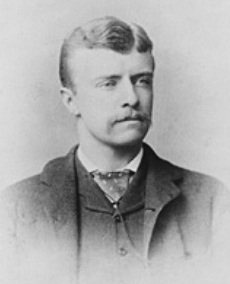
What Was Theodore Roosevelt’s Political Party
- The political party of Theodore Roosevelt was The Republican Party.
The Rise Of Theodore Roosevelt
- ‘The Rise of Theodore Roosevelt’ is a biography book of Theodore Roosevelt written by Edmund Morris.
- It was originally published in 1979.
- The book covers all the time from his birth to ascendance to the presidency.
- In 1980, the book won the Pulitzer Prize for Biography and the National Book Award in Biography.
Who Influenced Theodore Roosevelt
- Theodore Roosevelt was greatly influenced by his father, Theodore Roosevelt Sr.
- He said about his father:
“My father, Theodore Roosevelt, was the best man I ever knew. He combined strength and courage with gentleness, tenderness, and great unselfishness. He would not tolerate in us children selfishness or cruelty, idleness, cowardice, or untruthfulness.”
Teddy Roosevelt War Of 1812
- Theodore Roosevelt wrote his first book “The Naval War of 1812” on the War of 1812, which was fought between the United States and the United Kingdom.
- His book covers the naval technologies and battles used during that war.
- The book is considered as a formative work in its field and had a huge influence on the formation of the modern United States Navy.
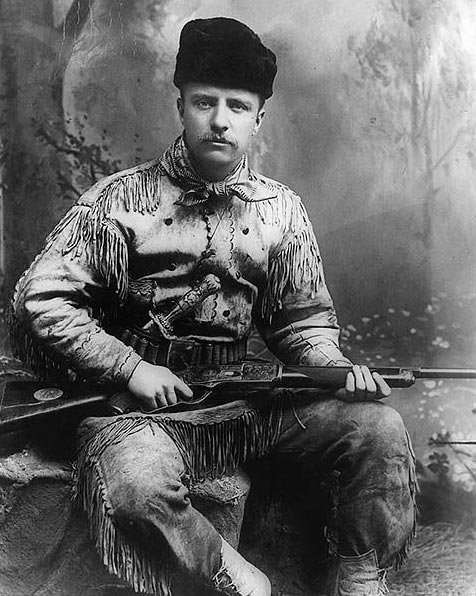
Who Did Teddy Roosevelt Lose To In 1912
- In the presidential election of 1912, Theodore Roosevelt lost to the Democratic Presidential nominee Thomas Woodrow Wilson.
How Did Teddy Roosevelt Became President
- Theodore Roosevelt became president after the assassination and unexpected death of President William McKinley.
President Before Teddy Roosevelt
- Before Theodore Roosevelt, William McKinley was the president of the USA.
Next President After Teddy Roosevelt – President After Theodore Roosevelt
- After Theodore Roosevelt, Willam Howard Taft was the next president of the USA.
Teddy Roosevelt President Number
- Teddy Roosevelt was the 26th president of the USA.
Teddy Roosevelt President Years – Teddy Roosevelt Era
- Theodore Roosevelt was president from 1901 to 1909.
Who Was Teddy Roosevelt’s Vice President
- The vice president of Theodore Roosevelt was Charles W. Fairbanks.
When Did Theodore Roosevelt Die – Where Did Theodore Roosevelt Die
- Theodore Roosevelt died on 6 January 1919 at his home Sagamore Hill in Oyster Bay, New York.
How Did Theodore Roosevelt Die
- Theodore Roosevelt died because of breathing problems.
- A blood clot caused his death, which was detached from a vein and traveled to his lungs.
Who Shot Theodore Roosevelt
- A saloonkeeper, John Flammang Schrank, shot Theodore Roosevelt while he was campaigning in the Milwaukee city of Wisconsin state.
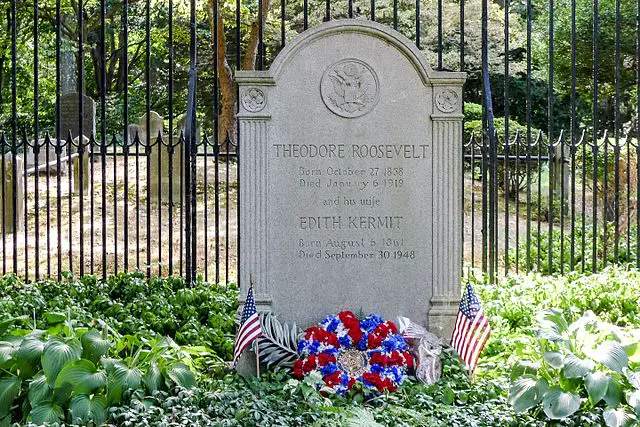
Who Won The Nobel Peace Prize In 1906
- 26th US President, Theodore Roosevelt won the Nobel Peace Prize of 1906.
- He won it for his successful efforts to end the war between Russia and Japan.
What Were Theodore Roosevelt’s Accomplishments? – Works Of Theodore Roosevelt
The following are some of the major works and accomplishments of Theodore Roosevelt as a president of the United States:
The Square Deal
- The Square Deal was a domestic program.
- There were 3 major goals of this program; conservation of natural resources, corruption control, and protection of consumers.
- This program aimed to help middle class citizens from bad trusts and plutocracy, as well as to secure businesses from the extreme demands of trade unions (organized labor).
- In simple words, Roosevelt wanted to create an honest and fair society, in which every person has equal chances to succeed.
Activation of the Sherman Antitrust Act of 1890
- Activation of the Sherman Antitrust Act of 1890 is one of the major accomplishments of Theodore Roosevelt.
- Using this act, Roosevelt prosecuted 44 antitrust suits.
- He broke up and regulated the most prominent trusts (the bad-trusts) of the country, including the largest railroad monopoly and the largest oil and refinery company.
Creation of the United States Department of Commerce and Labor
- Theodore Roosevelt succeeded to create the United States Department of Commerce and Labor in 1903.
- This department was responsible for controlling the excesses of big businesses.
- This department also included the investigatory agency; the Bureau of Corporation. The major aim of the Bureau was to study and report on the industry, especially for monopolistic practices.
Pure Food and Drug Act
- Theodore Roosevelt persuaded to pass the Pure Food and Drug Act.
- It was the first of the Consumer Protection Laws.
- The major aim of this Act was to prohibit interstate and foreign traffic in mislabeled and adulterated food and drug products.
- This Act then led to the creation of the Food and Drug Administration (FDA).
Federal Meat Inspection Act
- The Federal Meat Inspection Act was also one of the Consumer Protection Acts.
- It was signed by President Thodore Roosevelt on the same day along with the Pure Food and Drug Act.
- The main purpose of this Act was to prohibit adulterate or mislabeled meat and meat products.
- The Act was also concerned to ensure that the slaughtering and processing of meat and meat products are carried out under strictly regulated sanitary conditions.
Conservation of Natural Resources
- One of the most prominent works of Theodor Roosevelt was the conservation of natural resources, forests, and wildlife.
- He withdrew up to 148,000,000 acres of forests, 1,500,000 acres of land of water power sites, and 80,000,000 acres of mineral lands from the public domain.
- As a president, he also used executive orders on many occasions to protect wildlife and forests.
The Panama Canal
- Building the Panama Canal is also one of Theodore Roosevelt’s most prominent works.
- Theodore Roosevelt started work on the project of Panama Canal in 1904, which was completed in 1914.
- The purpose of building the canal was to link the Pacific and the Atlantic Oceans.
- When the canal was opened, around 1000 ships crossed it during the first year.
- In 2008, the annual traffic on the canal was more than 14,000 vessels.
How Did Roosevelt Feel About Trusts – What Trusts Did Roosevelt Bust
- Theodore Roosevelt was mythologized as the trust-buster due to his aggressive use of the Sherman Antitrust Act of 1890.
- However, in reality he was more of a trust regulator than a trust-buster.
- He did not oppose all trusts and believed that large businesses are a necessary part of the United States economy.
- So he pursued only to prosecute “bad trusts” that kept trade under control and harmed the public by charging unfair prices.
- He prosecuted a total of 44 antitrust suits.
- He broke up the largest railroad monopoly; the Northern Security Company and regulated the largest oil and refinery company; Standard Oil.
How Did Theodore Roosevelt Advance The Progressive Agenda – How Did Theodore Roosevelt Support Progressive Reforms
- Theodore Roosevelt was one of the most effective spokespersons of progressivism, which was one of the most powerful political forces at that time.
- Through congress, he advanced several pieces of the progressive agenda by deciding to create a domestic program between business and labor known as the “Square Deal”.
- There were three main goals of the Square Deal:
- Conservation of natural resources
- Corruption control
- Protection of consumers
- In 1901-1909, he explained:
“When I say that I am for the square deal, I mean not merely that I stand for fair play under the present rules of the game, but that I stand for having those rules changed so as to work for a more substantial equality of opportunity and of reward for equally good service.”
- Historian G. Warren Chessman describes the characteristics and priorities of Theodore Roosevelt as a President as;
“insistence upon the public responsibility of large corporations; publicity as a first remedy for trusts; regulation of railroad rates; mediation of the conflict of capital and labor; conservation of natural resources; and protection of the less fortunate members of society”.

President Theodore Roosevelt Progressive Era – Who Is A Progressive Theodore Roosevelt Summary – Roosevelt And Progressivism
- The progressive era was a period from the 1890s to 1920s, in which political reform and widespread social activism happened throughout the United States.
- The major aims of the Progressive movement were to address problems caused due to industrialization, political corruption, urbanization, and immigration.
- Theodore Roosevelt was one of the most effective spokespersons of national progressivism.
- When he entered the White House after the assassination of McKinley, his age was only 42.
- He had intense sympathies with democracy and also was well familiar with the modern urban problems due to his experience as a police commissioner of New York City and governor of the New York state
- At that time, Congress was in the control of a group of extremely conservative Republicans. So as a new President, Theodore Roosevelt cautiously proceeded in legislative matters.
- However, when he won the election of 1904, he appeared a full-grown and popular leader of the people.
- Until 1906, Theodore Roosevelt became the undisputed spokesman and best publicity agent of National Progressivism.
- In 1901, American citizens were alarmed about the spread of so-called trusts (industrial combination), which they blamed as responsible for the continuous increase of prices since 1897.
- Theodore Roosevelt activated the Sherman Antitrust Act of 1890, which was inactive because of the refusal of the previous presidents (Cleveland and McKinley) to enforce it, and because of the Supreme Court’s decision that the Act does not apply to combinations in manufacturing.
- In 1902, Theodore Roosevelt started with a suit to break up a northwestern railroad monopoly, and he took action against the Beef Trust, then against Standard Oil, tobacco, and other monopolies.
- He brought a total of 44 antitrust suits and the Supreme Court supported the administration in every case.
- In 1902, he interceded on the behalf of labor to force the arbitration of a strike by the United Mine Workers of America against the operators of Pennsylvania anthracite coal. This action of Roosevelt was never done or known before in the presidential history of the United States.
- In 1903, Theodore Roosevelt also persuaded disinclined Congress to establish a Bureau of Corporations as an investigatory agency within the Department of Commerce and Labor to investigate business practices.
- After winning the presidential election of 1904, Theodore Roosevelt advanced much aggressively.
- In 1905 and 1906, Roosevelt struggled to give power to the Interstate Commerce Commission (ICC) to effectively regulate the interstate railroad rates. The outcome of his efforts was the Hepburn Act of 1906, which greatly enlarged the jurisdiction of ICC and forbade the railroads from increasing rates without its approval.
- In 1906, Roosevelt became successful to pass the Meat Inspection Act and the Pure Food and Drug Act.
- Theodore Roosevelt also campaigned to conserve the natural resources of the nation. He withdrew 80,000,000 acres of mineral lands, 148,000,000 acres of forest land, and 1,500,000 of water-power sites from the public domain.
Teddy Roosevelt Best Known For – How Did Theodore Roosevelt Become Famous
- Polls of political scientists and historians rank Theodore Roosevelt as one of the five best presidents of the United States.
- The following are some of the works for which Theodore Roosevelt became famous and is best known:
- As a national hero of the Spanish-American War
- As a prominent leader of the Progressive Movement
- As a champion of the “Square Deal”
- Promising to protect the rights of the average citizens
- Breaking the bad trusts
- Regulation of the railroad monopoly
- Creation of Pure Food and Drugs Act
Patriotism Theodore Roosevelt
- Theodore Roosevelt says about patriotism:
“Patriotism means to stand by the country. It does not mean to stand by the president or any other public official, save exactly to the degree in which he himself stands by the country. It is patriotic to support him insofar as he efficiently serves the country. It is unpatriotic not to oppose him to the exact extent that by inefficiency or otherwise he fails in his duty to stand by the country. In either event, it is unpatriotic not to tell the truth, whether about the president or anyone else.”
Theodore Roosevelt The Adventurous President
- “Theodore Roosevelt: The Adventurous President” is a biography and nonfiction literature type of book for children.
- It is written and edited by Lisa DeMauro.
- It was published on January 4, 2005.
Roosevelt And Conservation – Teddy Roosevelt And Conservation – Theodore Roosevelt And Conservation
- Theodore Roosevelt put the issue of conservations higher on the national agenda.
- He was a prominent conservationist and the purpose of his efforts was not only to protect the environment, but also to ensure that the society as a whole is benefiting from the natural resources of the country, not only the selected individuals or companies.
- He worked closely with James Rudolph Garfield (the Interior Secretary) and Gifford Pinchot (Chief of the United States Forest Service) to approve a series of conservation programs.
- He also established the United States Forest Service and enacted the creation of 5 National Parks.
- He signed the Antiquities Act of 1906, under which he officially announced 18 new U.S. National Monuments.
- He established 150 National Forests, 51 bird reserves, and 4 game preserves.
- He placed a total of about 230 million acres (930,000 square kilometers) land of the country under public protection.
- As a president, he used executive orders on many occasions to protect forests and wildlife.
- At the end of his second term presidency, he established 150 million acres (600,000 square kilometers) of reserved forestry land by using executive orders.
- To prevent Theodore Roosevelt from reserving lands anymore, Senator Charles Fulton attached an amendment to a bill of agricultural appropriations.
- Theodore Roosevelt used more executive orders for the establishment of 21 more forest reserves before signing that bill into law.
- In 31 states, he established a total of 121 forest reserves by using executive orders.
Roosevelt And Imperialism
- Imperialism is an ideology or policy, in which a country extends its authority or rule over other countries and people through the use of military force or controlling the economy or politics.
- Theodore Roosevelt was an imperialist and pursued ports and colonies throughout the world during his presidency to exert American influence.
- Like his predecessors, he forced influence on Philippine, which finally took independence from America in 1946.
- He advocated the American annexation of Hawaii for many reasons including; to deny Japanese expansion, to get a good port at Pearl Harbor for battleships, and to get a way in the central markets in Asia.
- In Central America, he exerted influence on Columbia to take Panama and fulfill the old American dream of building a canal to link the Pacific and Atlantic Oceans.
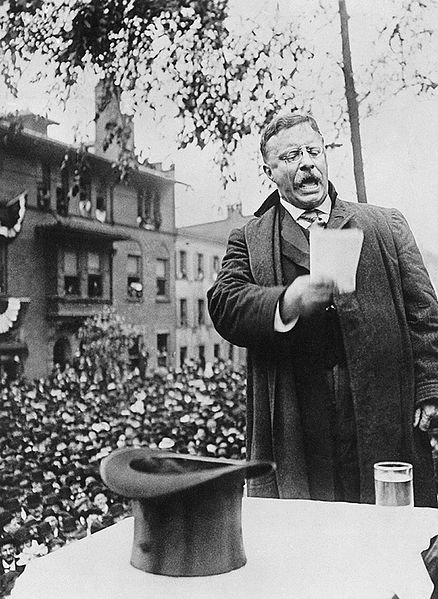
Theodore Roosevelt For The Defense
- “Theodore Roosevelt For The Defence: The Courtroom Battle to Save His Legacy” is a biography book written by David Fisher and Dan Abrams.
- It was published originally on 21 May 2019.
- The book was nominated for the Audie Award for History/Biography.
What Was Theodore Roosevelt’s Foreign Policy – Theodore Roosevelt Foreign Policy
- The foreign policy of President Theodore Roosevelt is known as big stick ideology or big stick diplomacy.
- From this, Theodore Roosevelt meant;
“speak softly and carry a big stick; you will go far.”
- He described his foreign policy style as;
“the exercise of intelligent forethought and of decisive action sufficiently far in advance of any likely crisis.”
- The big stick diplomacy of Roosevelt had five components;
- Having a strong and serious military capability was essential that would force the opponent to pay full attention. At that time it meant the world’s best navy.
- Act fairly towards other nations.
- Never to blunt
- Attack only when prepared for hard attack
- Willingness to avoid the humiliation of the opponent in defeat
- He used this diplomacy on several occasions in Latin America, especially, to build the Panama Canal to link the Pacific and Atlantic Oceans.
- Theodore Roosevelt played a key role to end the War between Russia and Japan. He supervised the peace negotiations as neutral between the two countries and his efforts resulted in the Treaty of Portsmouth, which ended the war in September 1905.
Roosevelt Great White Fleet
- The Great White Fleet was a group of United States battleships that completed a voyage around the globe on the order of President Theodore Roosevelt.
- This voyage was started on 16 December 1907 and completed on 22 February 1909.
- The purpose of this mission was to make friendly visits to numerous countries while exhibiting to the world the new naval powers of the United States.
Teddy Roosevelt And The Environment
- As a president of the United States, Theodore Roosevelt largely used executive orders to protect the environment and he was unapologetic about this.
- He issued executive orders and established 121 forest reserves in 31 states of the country.
- As compared to all of his predecessors combined, Theodore Roosevelt assigned more federal land for natural preserves and national parks.
- Gifford Pinchot was his key advisor on environmental matters.
- He transferred the control of national forests from the Department of the Interior to the Bureau of Forestry to increase the power of Pinchot over environmental issues.
- He also established the United States Forest Service.
- He created five national parks and signed the Antiquity Act of 1906 and proclaimed 18 new national monuments under this act.
- Furthermore, he established 150 national forests, 51 bird reserves, and four-game preserves.
Teddy Roosevelt On Immigration
- The presidential period of Theodore Roosevelt was a time of significant immigration.
- The United States welcomed more than 15 million immigrants between 1900 and 1915.
- During the presidency of Theodore Roosevelt, key immigration laws passed including;
- The Anarchist Exclusion Act of 1903, which prohibited the entry of political extremists, baggers, and abnormal people into the country.
- The Naturalization Act of 1906, which created a Bureau of Naturalization and Immigration within the United States Commerce Department. This act also added the requirement of English skills for naturalization.
- The Immigration Act of 1907, which added more categories to the list of those people with physical and mental disabilities, who were prohibited from entering the country.
- The Expatriation Act of 1907, required every woman to adopt her husband’s citizenship.
- Before his death, Theodore Roosevelt made his direct and well-known statement about immigration and naturalization. In 1919, he wrote in a letter:
“We have room for but one flag, the American flag, and this excludes the red flag which symbolizes all wars against liberty and civilization just as much as it excludes any foreign flag of a nation to which we are hostile. We have room for but one language here and that is the English language, for we intend to see that the crucible turns our people out as Americans, and American nationality, and not as dwellers in a polyglot boarding house; and we have room for but one soul [sic] loyalty, and that is loyalty to the American people.”
Teddy Roosevelt On Race – Theodore Roosevelt Civil Rights
- According to the author Christoper Kelin, the convection of Theodore Roosevelt that white people of European descent are by birth superior enlightened his actions on matters from foreign policy to national parks.
- About the difficult issue of race relations, Theodore Roosevelt once wrote to a friend,
“I have not been able to think out any solution of the terrible problem offered by the presence of the Negro on this continent, but of one thing I am sure, and that is that inasmuch as he is here and can neither be killed nor driven away, the only wise and honorable and Christian thing to do is to treat each black man and each white man strictly on his merits as a man, giving him no more and no less than he shows himself worthy to have”
- It was his fundamental belief that the greatness of America came from the ruling of racially superior white men of European descent.
- Like many progressives of that period, Theodore Roosevelt also had paternalistic and supercilious views about African-Americans. He once wrote in a letter to a friend’
“as a race and in the mass they are altogether inferior to whites”
- However, his attitude would be best understood if we compared him with other leaders of his time.
- When Roosevelt decided dinner with Booker T. Washington (dominant leader of the African-American community of that time) in White House, Benjamin Tillman (notable democratic senator from South Carolina) commented;
“The action of President Roosevelt in entertaining that nigger will necessitate our killing a thousand niggers in the South before they learn their place again”
- After dinner with Booker T. Washington, Roosevelt continuously spoke against lynching. However, he did very little effort for the advancement of the civil rights cause of the African-Americans.
- In 1906, Theodore Roosevelt dishonorably discharged three companies of black soldiers who all refused his order to tell what happened during a violent incident in Brownsville, Texas.
Theodore Roosevelt Civil War
- When the American Civil War started, Theodore Roosevelt was only about three years old.
- However, his father, Theodore Roosevelt Sr. was a great supporter of the Union during the Civil War.
Theodore Roosevelt Democrat
- Theodore Roosevelt was not a Democrat. He was a Republican.
Theodore Roosevelt On Moose
- There is a picture of Theodore Roosevelt, in which he rides a moose through a lake.
- However, the picture is fake and photoshopped.
How Did Roosevelt Use The Bully Pulpit
- A bully pulpit means a public position or office of authority that provides an opportunity to its occupant to speak out and to be heard on any issue.
- President Theodore Roosevelt originated this term and referred to his office as a “bully pulpit”.
- From this, he meant a terrific platform to promote an agenda.
- In the term, he used the bully word as an adjective from which he meant “wonderful” or “superb”.
Roosevelt Citizenship In A Republic – Duties Of American Citizenship Theodore Roosevelt
- “Citizenship in A Republic” is the title of a speech Theodore Roosevelt delivered on 23 April 1910, in Sorbonne Paris. It is one of his well-known and widely quoted speeches. It was a 35-page speech, and one of the remarkable passages is on page 7 of the speech, which is referred to as “The Man in the Arena”:
“It is not the critic who counts; not the man who points out how the strong man stumbles, or where the doer of deeds could have done them better. The credit belongs to the man who is actually in the arena, whose face is marred by dust and sweat and blood; who strives valiantly; who errs, who comes short again and again, because there is no effort without error and shortcoming; but who does actually strive to do the deeds; who knows great enthusiasms, the great devotions; who spends himself in a worthy cause; who at the best knows in the end the triumph of high achievement, and who at the worst, if he fails, at least fails while daring greatly, so that his place shall never be with those cold and timid souls who neither know victory nor defeat.”
- “Duties of American Citizenship” was the title of another speech Theodore Roosevelt delivered long before his presidency on 11 January 1883 in Buffalo, New York.
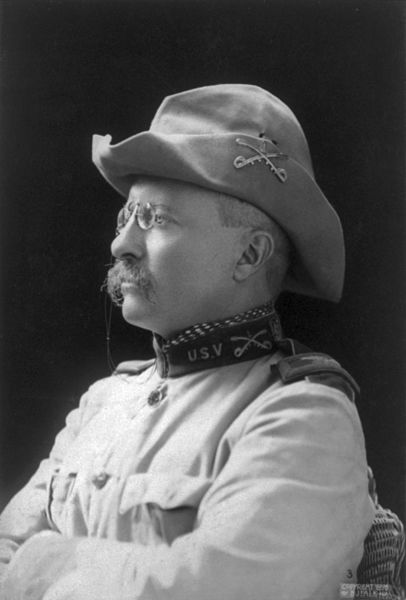
Theodore Roosevelt After Presidency
- Theodore Roosevelt went on an expedition to Africa shortly after the end of his second term presidency.
- He decided to run for the presidential election of 1912. However, he lost and his opponent Woodrow Wilson won the election.
- After that, he went on an expedition to South America to explore the River of Doubt in the Amazon Basin. During the expedition, he suffered serious diseases and his leg was also injured in a boat accident, which led to a serious infection.
- When he returned to the country, he spent his time writing books and scientific essays.
- When the outbreak of World War Ⅰ started in Europe, he led the cause for the preparedness of the military and convinced that America should join the war.
- However, when President Wilson called for neutrality, Roosevelt was greatly disappointed and criticized the inactivity of his country.
- In 1917, America finally joined the war. Theodore Roosevelt offered to organize a volunteer division, but the War Department refused his offer.
- All the four sons of Theodore Roosevelt volunteered to fight in the war.
- He was disheartened when his youngest son, Quentin, was shot down during a flying mission in Germany.
- After that, Theodore Roosevelt was not as enthusiastic as he was before while continuing to make speeches in the favor of war.
- On January 6, 1919, he died in sleep in his house at Oyster Bay, New York.
Gifford Pinchot And Theodore Roosevelt
- Gifford Pinchot was an American politician and forester.
- He was the head of the Bureau of Forestry during the Presidency of Theodore Roosevelt.
- Gifford Pinchot was also a subordinate and key advisor of president Roosevelt on environmental issues.
How Are FDR And Teddy Roosevelt Related – How Are Franklin And Theodore Related
- 32nd US President Franklin D. Roosevelt (FDR) was the fifth cousin of Theodore Roosevelt.
- The wife of Franklin D. Roosevelt, Eleanor Roosevelt was the niece of Theodore Roosevelt.
- Franklin was greatly inspired by Theodore Roosevelt, who has an important influence on his career.
How Is Eleanor Roosevelt Related To Theodore Roosevelt
- Eleanor Roosevelt was the niece of Theodore Roosevelt.
- She was the daughter of his younger brother Elliot Bulloch Roosevelt.
How Teddy Roosevelt Saved Football
- “The Big Scrum: How Teddy Roosevelt Saved Football” is a biography book written by John J. Miller.
- It was originally published on 12 April 2011.
- In the book, the author delivers the fascinating story of how Theodore Roosevelt saved American Football.
How Was Woodrow Wilson Different Than Theodore Roosevelt
- The major difference between Theodore Roosevelt and Woodrow Wilson was that Wilson used direct means to accomplish big goals.
- In foreign policy, Wilson emphasized moral persuasion and diplomacy while Roosevelt emphasized the use of power.
- The presidential style of Theodore Roosevelt was bold, while Wilson was reserved and scholarly.
How Was Woodrow Wilson Similar To Theodore Roosevelt
- There are many similarities between Theodore Roosevelt and Woodrow Wilson. The major ones are:
- Both were progressive leaders and reformers.
- Both Presidents enacted major social reforms.
- Another major similarity between Roosevelt and Wilson was the aggressive regulation of businesses.
Why Is Theodore Roosevelt On Mount Rushmore
- Theodore Roosevelt was chosen to be carved on Mount Rushmore because he was one of the most influential American Presidents and world leaders.
Teddy Roosevelt Africa
- In March 1909, Theodore Roosevelt went on an expedition (Smithsonian-Roosevelt African Expedition) shortly after the end of his presidency.
- The expedition aimed to collect animal specimens for the newly established Smithsonian Natural History Museum.
- Roosevelt and his group landed in the East African country Mombasa (now Kenya) and then traveled to the Central African country Belgian Congo (now the Democratic Republic of Congo). They then followed the Nile to Khartoum (in modern Sudan).
- They collected about 11,400 animal specimens.
- Theodore Roosevelt chronicled the expedition in his book ‘African Game Trial’.
Teddy Roosevelt Amazon River
- In December 1913, Theodore Roosevelt went on a survey expedition in the Amazon Basin to follow the path of the Rio da Dúvida (“River of Doubt”).
- Theodore Roosevelt and Brazilian Colonel Cândido Mariano da Silva Rondon jointly led the expedition.
- Their other well-known companions were Kermit Roosevelt (son of Theodore Roosevelt) and George Kruck Cherrie (American naturalist and explorer).
- The expedition ended in April 1914.
- They collected many new specimens of animals and insects for the American Museum of Natural History.
- During the voyage, they suffered diseases, starvation, and other problems.
- Theodore Roosevelt was nearly dead at the end of the expedition.
- The river they explored was eventually named “Rio Roosevelt” in the name of Theodore Roosevelt.
Teddy Roosevelt Letters
- Theodore Roosevelt himself wrote a book named The Letters of Theodore Roosevelt, which was originally published in 1951.
- The book makes a major contribution to American literature and history.
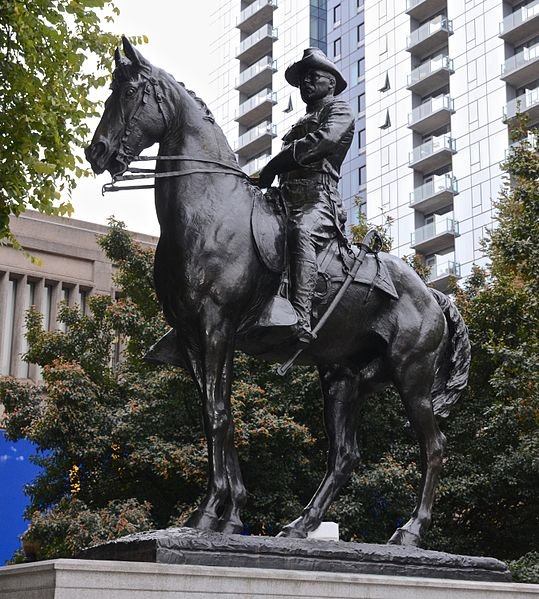
Theodore Roosevelt Quotes
- The following are some of the most famous quotes of Theodore Roosevelt:
“It is not the critic who counts; not the man who points out how the strong man stumbles, or where the doer of deeds could have done them better. The credit belongs to the man who is actually in the arena, whose face is marred by dust and sweat and blood; who strives valiantly; who errs, who comes short again and again, because there is no effort without error and shortcoming; but who does actually strive to do the deeds; who knows great enthusiasms, the great devotions; who spends himself in a worthy cause; who at the best knows in the end the triumph of high achievement, and who at the worst, if he fails, at least fails while daring greatly, so that his place shall never be with those cold and timid souls who neither know victory nor defeat.”
“To educate a person in the mind but not in morals is to educate a menace to society.”
“Knowing what’s right doesn’t mean much unless you do what’s right.”
“People don’t care how much you know until they know how much you care”
“It is hard to fail, but it is worse never to have tried to succeed.”
Theodore Roosevelt Books
- The following is a list of books Theodore Roosevelt wrote:
| S.No | Book Name | Year Published |
| 1 | The Rough Riders | 1889 |
| 2 | The Naval War of 1812 | 1882 |
| 3 | Ranch Life and The Hunting-Trail | 1888 |
| 4 | The winning of the West | 1889 |
| 5 | The Works of Theodore Roosevelt | 1882 |
| 6 | Hunting the Grisly and Other Sketches | 1889 |
| 7 | The Wilderness Hunter: An Account of the Big Game of the United States and Its Chase With Horse, Hound, and Rifle | 1889 |
| 8 | Hunting Trips of a Ranchman and The Wilderness Hunter | 1885 |
| 9 | New York | 1891 |
| 10 | Hunting in many lands | 1895 |
| 11 | Outdoor pastimes of an American hunter | 1905 |
| 12 | African Game Trails: An Account of the African Wanderings of an American Hunter-Naturalist | 1909 |
| 13 | The Right of the People to Rule | 1912 |
| 14 | The Conservation of Womanhood and Childhood | 1912 |
| 15 | Theodore Roosevelt, An Autobiography | 1913 |
| 16 | Through the Brazilian wilderness | 1914 |
| 17 | A book-lover’s holidays in the open | 1916 |
| 18 | Fear God and take your own part | 1916 |
| 19 | The foes of our own household | 1917 |
| 20 | Letters to his children | 1919 |
| 21 | The letters of Theodore Roosevelt | 1951 |
| 22 | The Man in the Arena: Selected Writings of Theodore Roosevelt: A Reader | 1987 |
| 23 | The wisdom of Theodore Roosevelt | 2003 |
